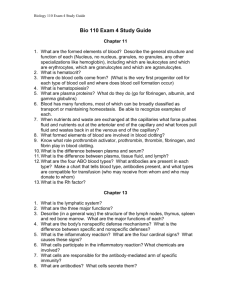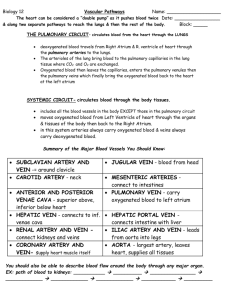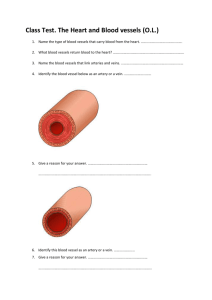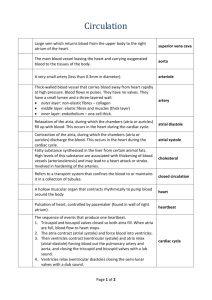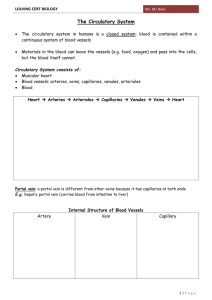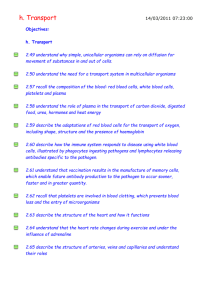Circulation Team-Game-Tournament Questions
advertisement
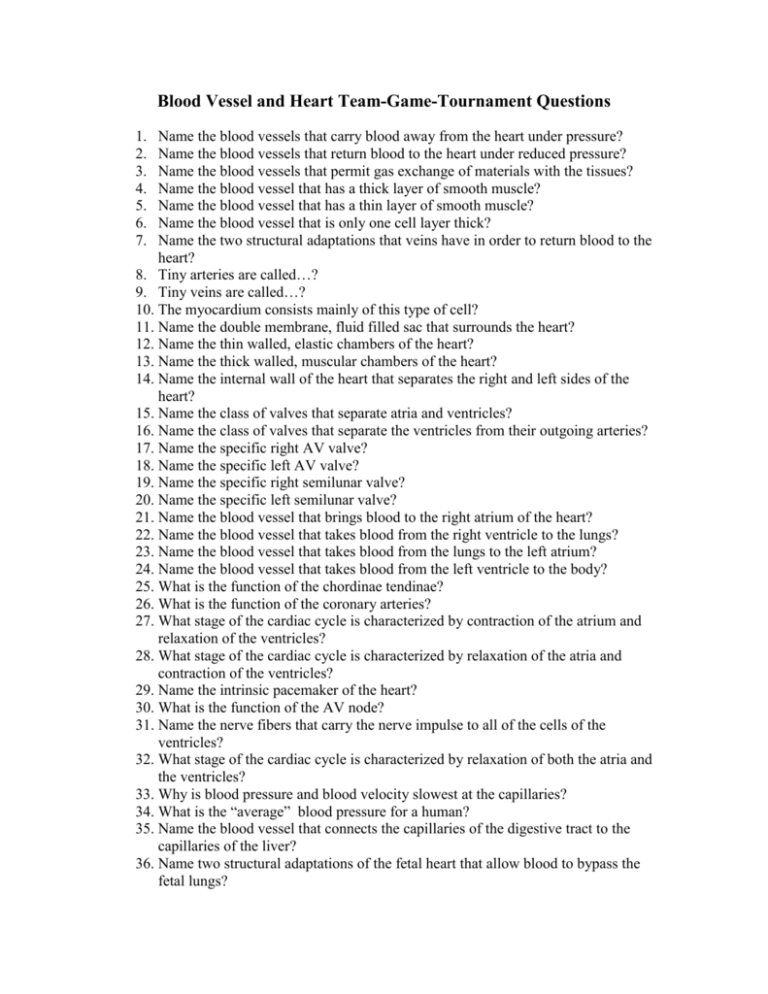
Blood Vessel and Heart Team-Game-Tournament Questions 1. 2. 3. 4. 5. 6. 7. Name the blood vessels that carry blood away from the heart under pressure? Name the blood vessels that return blood to the heart under reduced pressure? Name the blood vessels that permit gas exchange of materials with the tissues? Name the blood vessel that has a thick layer of smooth muscle? Name the blood vessel that has a thin layer of smooth muscle? Name the blood vessel that is only one cell layer thick? Name the two structural adaptations that veins have in order to return blood to the heart? 8. Tiny arteries are called…? 9. Tiny veins are called…? 10. The myocardium consists mainly of this type of cell? 11. Name the double membrane, fluid filled sac that surrounds the heart? 12. Name the thin walled, elastic chambers of the heart? 13. Name the thick walled, muscular chambers of the heart? 14. Name the internal wall of the heart that separates the right and left sides of the heart? 15. Name the class of valves that separate atria and ventricles? 16. Name the class of valves that separate the ventricles from their outgoing arteries? 17. Name the specific right AV valve? 18. Name the specific left AV valve? 19. Name the specific right semilunar valve? 20. Name the specific left semilunar valve? 21. Name the blood vessel that brings blood to the right atrium of the heart? 22. Name the blood vessel that takes blood from the right ventricle to the lungs? 23. Name the blood vessel that takes blood from the lungs to the left atrium? 24. Name the blood vessel that takes blood from the left ventricle to the body? 25. What is the function of the chordinae tendinae? 26. What is the function of the coronary arteries? 27. What stage of the cardiac cycle is characterized by contraction of the atrium and relaxation of the ventricles? 28. What stage of the cardiac cycle is characterized by relaxation of the atria and contraction of the ventricles? 29. Name the intrinsic pacemaker of the heart? 30. What is the function of the AV node? 31. Name the nerve fibers that carry the nerve impulse to all of the cells of the ventricles? 32. What stage of the cardiac cycle is characterized by relaxation of both the atria and the ventricles? 33. Why is blood pressure and blood velocity slowest at the capillaries? 34. What is the “average” blood pressure for a human? 35. Name the blood vessel that connects the capillaries of the digestive tract to the capillaries of the liver? 36. Name two structural adaptations of the fetal heart that allow blood to bypass the fetal lungs? 37. Name a structural adaptation of fetal circulation that allows blood to bypass the fetal liver? 38. State the relative amounts of carbon dioxide and oxygen in both the umbilical vein and the umbilical artery? 39. What is the purpose of the placenta? 40. Which adult vascular pathway circulates blood through the lungs? 41. Which adult vascular pathway circulates blood through the body’s organ systems? 42. Does the hepatic portal vein or the hepatic vein have the larger amount of glucose in the blood? 43. Does the pulmonary vein or the pulmonary artery have the larger amount of oxygen in the blood? 44. Does the renal artery or the renal vein have the larger amount of nitrogen waste in the blood? 45. How long in seconds is the cardiac cycle in a human being? 46. Does the sympathetic nervous system or the parasympathetic nervous system stimulate the pulse rate and blood pressure? 47. Does the hormone adrenalin/ epinephrine increase or decrease the pulse rate and blood pressure? 48. State five functions of the liver as they relate to the digestive, circulatory and lymphatic systems. 49. Name the two structural adaptations that allow blood to be shunted through capillary beds? 50. Identify the stages of the cardiac cycle that correspond to the P, QRS, and T stages of the ECG. Blood Vessel and Heart Team-Game-Tournament Answers 1. arteries 2. veins 3. capillaries 4. artery 5. vein 6. capillary 7. veins have valves, and veins have skeletal muscle contraction 8. arterioles 9. venules 10. cardiac muscle cell 11. pericardium 12. atria 13. ventricles 14. septum 15. atrioventricular valves 16. semilunar valves 17. tricuspid valve 18. bicuspid or mitral valve 19. pulmonary valve 20. aortic valve 21. superior and inferior vena cavae 22. pulmonary trunk or arteries 23. pulmonary veins 24. aorta 25. to keep the heart vales from inverting 26. to feed the heart first with oxygen and nutrients 27. atrial systole 28. ventricular systole 29. sinoatrial node 30. to amplify the nerve impulse from the SA node and transmit it through the ventricles 31. Purkinje fibers 32. atrial and ventricular diastole 33. to allow for diffusion of materials between blood and body tissues 34. 120/80 35. hepatic portal vein 36. oval opening , and the arterial duct 37. venous duct 38. umbilical vein= high oxygen and low carbon dioxide, while umbilical artery=low oxygen and high carbon dioxide 39. to attach fetus to wall of mother’s uterus, and two allow interface of mother’s and bay’s circulatory systems 40. pulmonary circuit 41. systemic circuit 42. hepatic portal vein has more glucose 43. pulmonary vein 44. renal artery 45. -.85 seconds 46. sympathetic nervous system 47. increase blood pressure and pulse rate 48. store glucose as glycogen; produce blood plasma proteins; detoxify blood; breakdown excess amino acids to ammonia; convert ammonia to urea; recycle dead red blood cells into bilirubin; convert bilirubin into bile salts. 49. precapillary sphincters and arteriovenous shunts 50. P = atrial systole; QRS =ventricular systole; T = atrial and ventricular diastole
